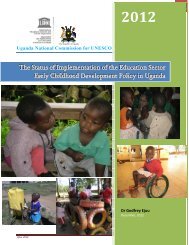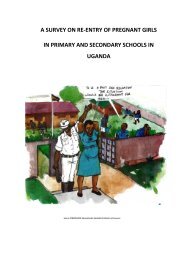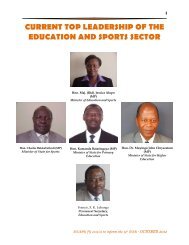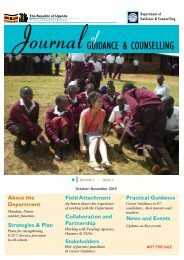Part I - Ministry Of Education and Sports
Part I - Ministry Of Education and Sports
Part I - Ministry Of Education and Sports
You also want an ePaper? Increase the reach of your titles
YUMPU automatically turns print PDFs into web optimized ePapers that Google loves.
(iv) Gender Parity in Primary Schools<br />
School access programs in the sector aim at reducing the gap between boys <strong>and</strong> girls in education so<br />
as to promote equality in lifelong opportunities. The programmes are intended to ensure that both<br />
boys <strong>and</strong> girls leave the school system with an education or vocational training according to their<br />
capabilities <strong>and</strong> free from gender categorization. Evidence available shows that the proportion of girls<br />
enrolling in school has increased in Ug<strong>and</strong>a. Enrolment of girls <strong>and</strong> boys at primary school level has<br />
reached the parity level. During the period under review, a total of 8,317,420 (Male 4,161,057; female<br />
4,156,363) pupils were enrolled in primary schools of which 50% were female. For the last two<br />
financial years, more girls were enrolled in school as compared to the boys. This indicates progress as<br />
far as educating the girl child is concerned. See table 4.6.<br />
Table: 4.6.Percentage share of pupils by gender<br />
FY 2010/11 2011/12<br />
Female 50.1% 50.0%<br />
Male 49.9% 50.0%<br />
Source: EMIS 2011/12<br />
(d) Constraints/Challenges<br />
Some of the key barriers to enhancing equitable access in the basic education subsector include the<br />
following;<br />
(i) Absenteeism of teachers <strong>and</strong> pupilsis crippling the Universal Primary <strong>Education</strong> (UPE)<br />
Programmes;<br />
(ii) Seven thous<strong>and</strong> shillings per child per year is no longer adequate considering the cost of<br />
living. It should be raised to atleast ten thous<strong>and</strong> shillings per child per year;<br />
(iii) Funds allocated under SFG/PRDP civil works are far below the need for construction of<br />
classrooms, teachers’ houses, <strong>and</strong> pit latrines;<br />
(iv) Insufficient teaching <strong>and</strong> learning materials;<br />
(v) Majority of teachers commute from very far due to inadequate teachers’ houses; <strong>and</strong>,<br />
(vi) There is a ban on grant aiding schools yet the dem<strong>and</strong> is very high.<br />
4.1.2 Secondary <strong>Education</strong><br />
Secondary education has experienced tremendous growth during the past decade. The introduction of<br />
Universal Secondary <strong>Education</strong> in 2007 resulted into increased enrolment to 1,106,000 in both<br />
government <strong>and</strong> private secondary schools (EMIS – 2011). However, in order to facilitate the students’<br />
development of knowledge <strong>and</strong> an underst<strong>and</strong>ing of the various emerging needs of society <strong>and</strong> the<br />
economy, the secondary education subsector, has come up with a number of policy objectives for FY<br />
2011/12 that include: to increase access <strong>and</strong> equity of secondary education; improving quality of<br />
secondary education; enhancing efficiency <strong>and</strong> effectiveness in the delivery of secondary education<br />
services; <strong>and</strong>, enhancing Public Private <strong>Part</strong>nership in the provision of Secondary <strong>Education</strong> to all<br />
Ug<strong>and</strong>ans.<br />
ESSAPR FY 2011/12 to inform the 19 th ESSR – OCTOBER 2012<br />
43








